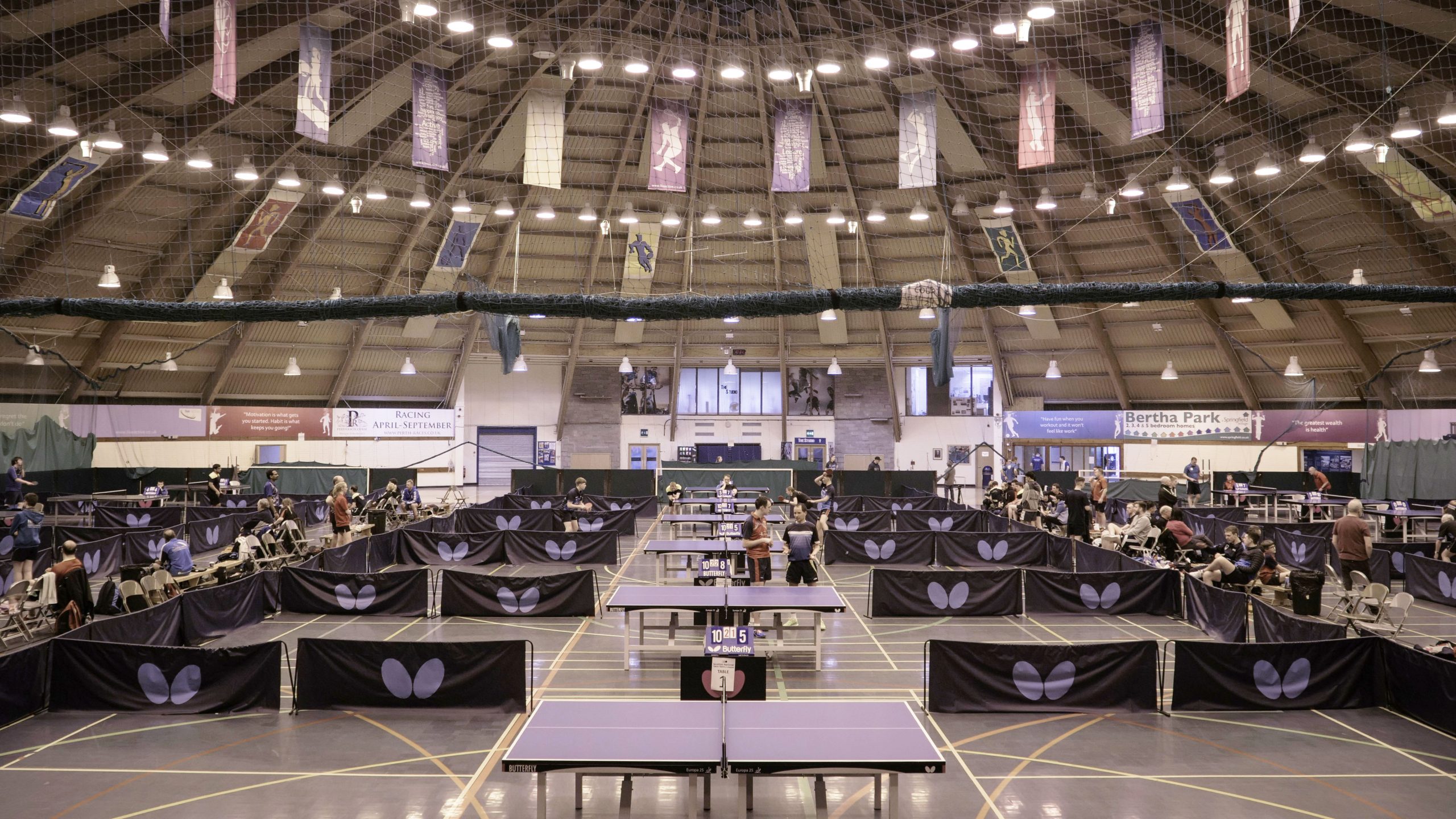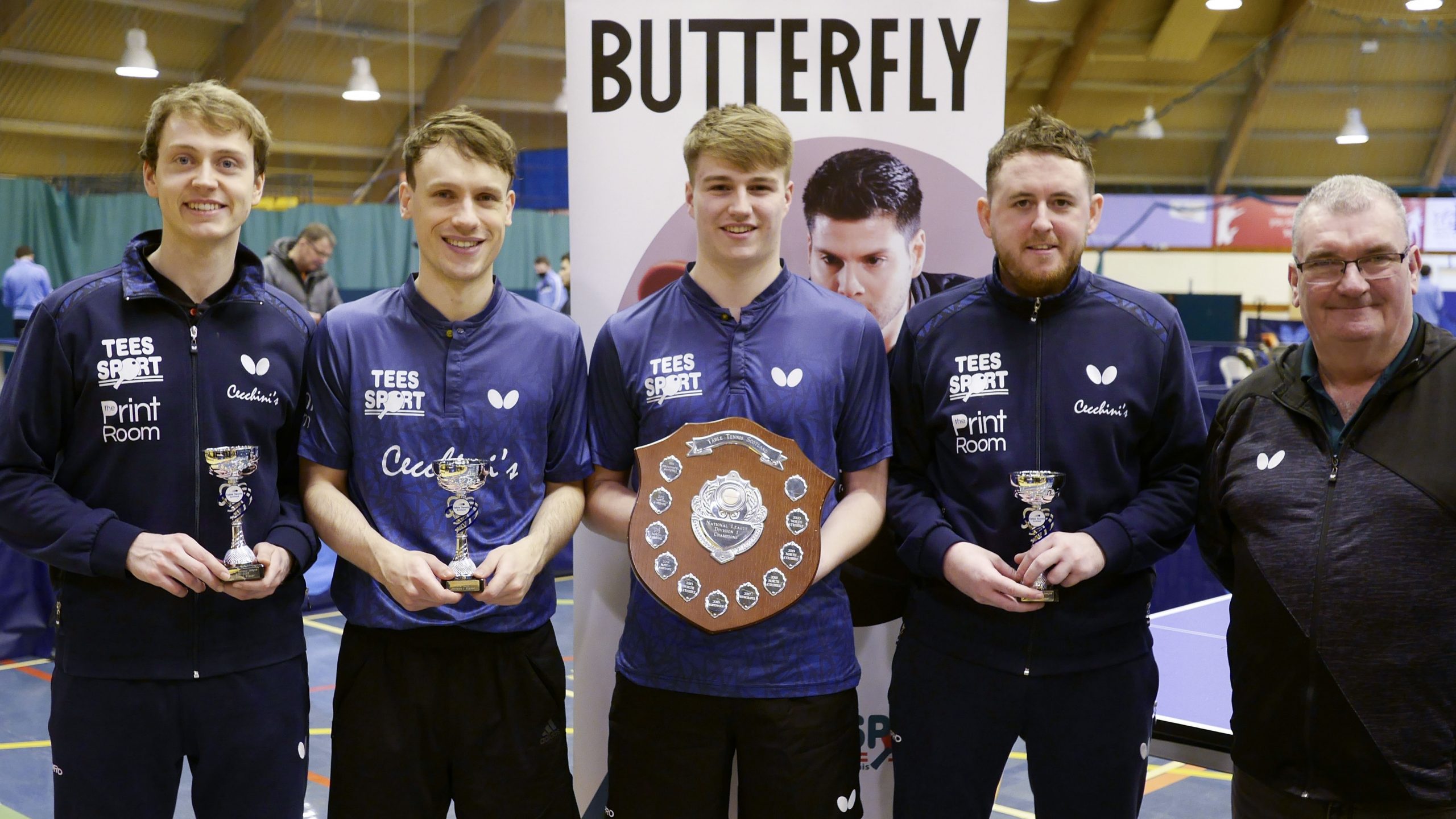
The Bell’s Sports Centre Main Arena (Photo: Charlie Ellis)
by Charlie Ellis
Though Scotland has produced a number of fine players over the years, including Helen Elliot (twice world champion in women’s doubles), the country hasn’t fulfilled its potential in table tennis. This piece looks at some encouraging signs for the growth of the game in Scotland.
Nestling on the fringes of Perth’s North Inch, Bell’s Sports Centre has the appearance of a cold war era research centre. Opened in 1968, it has a retro futuristic character. The dome (58 ft high and more than 200 ft in diameter) of its main arena remains impressive and the ‘sports umbrella’ a landmark within the Fair City. Inside, the place feels truly cavernous with the yellowing lighting adding a slight sense of unreality. The massive loudspeakers suspended from the ceiling look particularly ominous; like a colossal spider ready to pounce on the unsuspecting.
Named after the distiller and philanthropist A.K.Bell, Bell’s remains a key venue for a variety of sports, including basketball, gymnastics, hockey and badminton. The recent ‘stooshie’ over a plan to turn its wooden floored Coaching Hall (added to Bell’s in 1983) into a fitness and exercise studio, at a cost of £750k, illustrated the issues such a venue has in adapting to changing patterns in sport and leisure.
nnnnnnnnnn
Incessant action
In early February Bell’s hosted the final set of fixtures of the Scottish National League in table tennis. Yes, table tennis is a serious, highly competitive sport in Scotland – even if it has a low profile. Across the country, active local leagues exist and at the elite level Scotland has a promising crop of young talent.
The National League has grown steadily since it was re-established in 2010. 43 teams currently compete in 6 divisions and it is a key event for Table Tennis Scotland (TTS), the sport’s governing body. Players from all over the country convened at Bell’s, including teams from Dumfries, Aberdeen and a new club in the Highlands. The hall was abuzz with over 120 players, as well as coaches, supporters and officials. Looking down from the viewing platform, the place was a maelstrom of applause, groans of disappointment and ‘chos’. From 9am until 4:30pm, the action was incessant, reaching a crescendo with a league-deciding final match.
The competition features several of Scotland’s leading players including women’s no. 1 Rebecca Plaistow and Colin Dalgleish, the Men’s No. 2, as well as some of its most promising younger players in Danny Dajwa, Martin Johnson and Borui Chen. The National League also involves a range of players of different ages and ability levels. It is a fundamentally highly accessible sport and also one ideally suited to the ‘changeable’ Scottish climate. Though several table tennis tables are to be found in public parks around Scotland (one was recently installed at the East end of the Meadows in Edinburgh), it’s rare for the weather to be still and warm enough for an enjoyable game outdoors.
As an indoor sport it suffered badly during the pandemic, with leagues in Scotland suspended and tournaments cancelled. The National League has been one of the few major tournaments this season, though in the coming weeks, Bell’s will also host the Scottish National Championships and the Inter-League weekend, where players from Scotland’s local leagues battle it out in a team event.
nnn
A sport to be reckoned with
Despite the distinct signs of health evident in the National League, the sport remains underappreciated and overlooked. Competitive table tennis tends to take place beyond the gaze of publicity, with local league matches generally played in church halls, schools, private sports clubs and other out of the way places. It’s a strength of the sport that it can be played in such places but also a weakness in terms of its public profile. Very few members of the public are aware that games are played up to 11 these days, not 21; or that the balls are now larger and made of plastic (not celluloid).
Most people have played ‘ping pong’ at some time in their lives, so it’s often seen as a gentle pastime and not a proper sport. Anyone who has seen a vigorous ‘multiball’ session -in which a coach fires dozens of balls per minute, forcing the player to move and hit with tremendous speed – will soon be disabused of this view.
The intensity of some of the matches at Bell’s demonstrated the physically and mentally demanding character of the sport. Table tennis requires speed and dynamic movement but also touch, control and subtle bits of deception. The spin produced by the players (and the hyper-grippy rubber sheets they cover their bats with) can be extraordinary. Frankly, any social ping pong player would struggle to return the spinny serves of even the average club player. Even players with years of experience often find themselves perplexed by the spin on the ball. Returning serve can be an exasperating experience, akin to trying to get a frightened kitten into a basket while loud, discordant music is playing.
Psychiatrist Daniel Amen recently described the sport as ‘the world’s best brain sport”, as it stimulates five different parts of the brain at the same time. Studies have shown it to be effective in counteracting the onset of dementia. Prior to the pandemic, sessions were being run in care homes in Edinburgh and at the Eric Liddell Centre in Edinburgh (named after the rugby player and Olympic gold medal winning athlete).. Table tennis has great potential to help people maintain physical and mental health and sharpness.
nnnn
Table tennis works
The sport has received a boost to its profile through being adopted as the office game of choice in many tech companies. Table Tennis Scotland has recently sought to connect to this trend through offering companies discounted table tennis kits to allow them to play in their offices. As Richard Yule, Chief Operations Officer of TTS, has recently written in The Herald, works teams used to be the backbone of local leagues, with matches taking place in canteens and social clubs. Rolls Royce played in the West of Scotland League while, prior to closing in 1993, the electrical engineering company Ferranti had teams in the Edinburgh & Lothians League. De-industrialisation hit the sport hard, with local leagues waning in its wake. TTS’s aim is to embed the sport in modern offices and encourage the same sense of ‘community solidarity’ engendered by workplace sport in the past.
The hope is that this will build on the success of the ‘Pop in & Play’ venues which have opened in recent months. These make use of unused units in shopping centres and allow members of the public to pop in while out on a shopping trip. The venues at The Gyle and Ocean Terminal shopping centres (run by Murrayfield Table Tennis Club) have already proved highly popular and have offered a fantastic ‘shop window for the sport’. Similarly the Bounce group of table tennis bars have attracted a new group to table tennis in their stylish premises in central London.
The highly successful social ping pong venture Wiff Waff Wednesday in Leith, has demonstrated the democratic character of the sport, accessible to all. It shows that it’s a sport that can be enjoyed at any level and for those of varying physical ability. Para table tennis, as championed in Scotland by Terry McLernon, has grown recently. Drumchapel’s Martin Perry has shown what is possible, developing into one of the UK’s top para players. Ryan Henry of North Ayrshire has also achieved impressive results recently. It’s a question of getting more people involved and enjoying the sport – and then developing the talent that emerges. At present the sport has too small a talent pool, especially in the women’s game.
mm
North Ayrshire’s Day
The final day at the national league saw North Ayrshire A win the league for a record eighth time. Highly impressive for a club which only began in 2003. Club chairman Billy Main beamed with pride at the end, as his son Chris won the final match to close out a 5-1 victory versus closest rivals Murrayfield A. Murrayfield celebrate their 100th Anniversary this year but will have to wait a season for another crack at the National League.

North Ayrshire, 2022 Scottish National League Champions (Photo: Charlie Ellis)
North Ayrshire have demonstrated what can be achieved with a determined approach. Particularly notable has been the way the club ‘cascades’ it’s knowledge by encouraging young players to coach as well as play. Scotland has a good number of strong clubs, rooted in their communities; Dumfries, Drumchapel, Aberdeen among them. These however remain relatively isolated pockets of excellence. A new club has started in recent years in the Highlands, while there has been a rapid expansion of table tennis in East Lothian in the last few years. Such projects take a substantial amount of effort to get off the ground and develop.
These new clubs have picked up on the unmet demand for the sport. The sport needs more of them and for them to develop into fully professional clubs who own and run their own facilities.This is something that Eddie Still, national coach in the 1960’s, proposed but it never materialised. The model exists in countries such as Germany, France and Sweden, helping them to remain competitive against the Asian giants, Japan, South Korea and the powerhouse that is China. Two of Scotland’s best young players, Danny Bajwa and Martin Johnson recently spent a year in Germany, training with 12 times European Cup winners Borussia Dusseldorf. The experience boosted Bajwa and Johnson’s development substantially but also served to illustrate the gulf in the level of training available in the two countries.
As Richard Yule has commented, it is always going to be difficult to compete in the national sport of a country such as China. However, a nation as small as Sweden (10.43 million) has had a remarkable record, regularly beating China in the late 1990s and early 2000s and recently won 2 medals at the World Championships in Houston. Such examples provide hope. The recent voguishness of the sport has given it a boost. It gives table tennis a chance to fulfil its fantastic potential. As Yule ruefully reflects, at present we are ‘not doing justice to the sport and how popular it could be’. So, will it grow or will it remain the preserve of a few hundred devotees, flinging themselves around under Bell’s giant timber arches?
Charlie Ellis is a researcher and EFL teacher based in Edinburgh. He thanks Gordon Muir for his comments on an earlier version of this piece.
